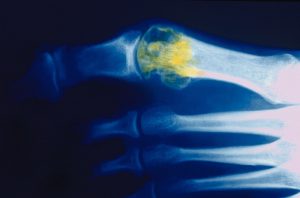Medications in the Pipeline for Gout Treatment Are Promising

Recent progress in the development of new drugs to treat gout, which specialists consider to be undertreated, has given rheumatologists more optimism regarding future urate-lowering therapies.
More potent and better-tolerated anti-inflammatory formulations may decrease pain and reduce periods of disability during attacks, says Robert T. Keenan, MD, a Duke rheumatologist who specializes in gout.
Keenan is the lead author of a review on new and pipeline drugs published in the April 2016 issue of Current Rheumatology Reports. He recommends that future gout medications effectively target the steps of the “inflammatory cascade” while limiting adverse effects.
Keenan’s article highlights the potential efficacy of inhibiting interleukin-1 (IL-1). Anti-inflammatory therapies using IL-1 inhibitors may treat and prevent attacks, Keenan notes, without exacerbating such conditions as diabetes mellitus, hypertension, and renal disease.
Newer uricosuric drugs improve treatment by increasing the excretion of uric acid and reduce the concentration of uric acid in blood plasma. In addition to uricosuric drugs, arhalofenate, an anti-inflammatory medication, offers promise through its dual action of lowering urates and reducing inflammation. These combined actions simplify patient responsibility, thereby improving compliance and, in more severe cases, help to reach a target serum urate level below 6 mg/dL.
The majority of established gout treatments are therapeutic and inexpensive, Keenan says, but comorbidities, intolerance, and unresponsiveness limit their effectiveness. In addition, he notes that some existing formulations do not effectively help patients reach the target serum urate level in cases involving severe gout, higher urate levels, or both.
Describing it as the “most common inflammatory arthropathy in the western world,” Keenan says increasing attention paid to new gout formulations will help inform health care professionals about treatment options. “Despite an evolving understanding of how gout and hyperuricemia occur, they're still undertreated,” says Keenan.